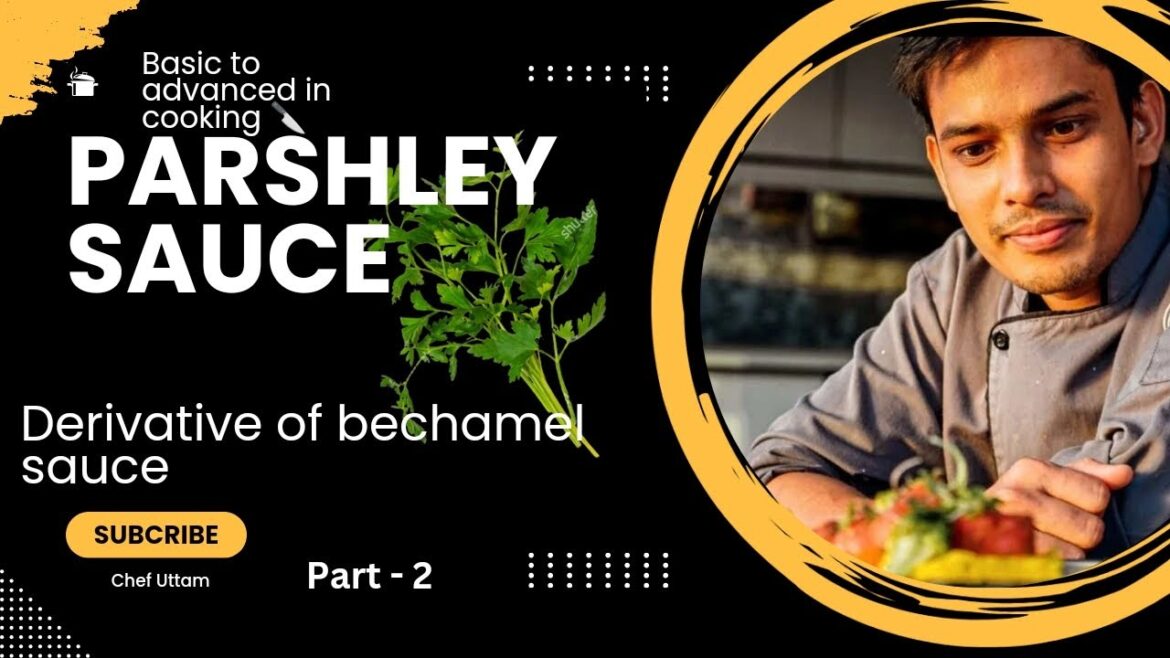Parshley sauce/derivatives of Béchamel sauce/ mother sauces/ by chef uttam/ part – 2#viral #trend
This is parshley sauce one of the mother sauces’s béchamel’s derivatives sauce.
Parsley, or garden parsley (Petroselinum crispum) is a species of flowering plant in the family Apiaceae that is native to Greece, Morocco and the former Yugoslavia.[1] It has been introduced and naturalized in Europe and elsewhere in the world with suitable climates, and is widely cultivated as a herb, and a vegetable.
Garden parsley is a bright green, biennial plant in temperate climates, or an annual herb in subtropical and tropical areas.
Where it grows as a biennial, in the first year, it forms a rosette of tripinnate leaves 10–25 cm long with numerous 1–3 cm leaflets, and a taproot used as a food store over the winter. In the second year, it grows a flowering stem to 75 cm (30 in) tall with sparser leaves and flat-topped 3–10 cm diameter umbels with numerous 2 mm diameter yellow to yellowish-green flowers.[9][11][12]
The seeds are ovoid, 2–3 mm long, with prominent style remnants at the apex. One of the compounds of the essential oil is apiole. The plant normally dies after seed maturation.[9][11][12]Parsley is widely used in Middle Eastern, Mediterranean, Brazilian, and American cuisine. Curly leaf parsley is used often as a garnish. Green parsley is used frequently as a garnish on potato dishes (boiled or mashed potatoes), on rice dishes (risotto or pilaf), on fish, fried chicken, lamb, goose, and steaks, as well as in meat or vegetable stews (including shrimp creole, beef bourguignon, goulash, or chicken paprikash).[13]Parsley seeds are also used in cooking, imparting a stronger parsley flavor than leaves.[14][citation needed]
Parsley, when consumed, is accredited with neutralising odours associated with garlic in cooking.[15]
In central Europe, eastern Europe, and southern Europe, as well as in western Asia, many dishes are served with fresh green, chopped parsley sprinkled on top. In southern and central Europe, parsley is part of bouquet garni, a bundle of fresh herbs used as an ingredient in stocks, soups, and sauces. Freshly chopped green parsley is used as a topping for soups such as chicken soup, green salads, or salads such as salade Olivier, and on open sandwiches with cold cuts or pâtés.
Persillade is a mixture of chopped garlic and chopped parsley in French cuisine.
Parsley is the main ingredient in Italian salsa verde, which is a mixed condiment of parsley, capers, anchovies, garlic, and sometimes bread, soaked in vinegar. It is an Italian custom to serve it with bollito misto or fish. Gremolata, a mixture of parsley, garlic, and lemon zest, is a traditional accompaniment to the Italian veal stew, ossobuco alla milanese.
In England, parsley sauce is a roux-based sauce, commonly served over fish or gammon. It is also served with pie and mash in the East End of London, and in fact all over London and The Home Counties, where it is referred to as Liquor.[original research?]
Root parsley is very common in Central, Eastern, and Southern European cuisines, where it is used as a snack or a vegetable in many soups, stews, and casseroles, and as ingredient for broth.
Tabbouleh salad
In Brazil, freshly chopped parsley (salsa) and freshly chopped scallion (cebolinha) are the main ingredients in the herb seasoning called cheiro-verde (literally “green aroma”), which is used as key seasoning for major Brazilian dishes, including meat, chicken, fish, rice, beans, stews, soups, vegetables, salads, condiments, sauces, and stocks. Cheiro-verde is sold in food markets as a bundle of both types of fresh herbs. In some Brazilian regions, chopped parsley may be replaced by chopped coriander (also called cilantro, coentro in Portuguese) in the mixture.
Parsley is a key ingredient in several Middle Eastern salads such as Lebanese tabbouleh; it is also often mixed in with the chickpeas and/or fava beans while making falafel (that gives the inside of the falafel its green color). It is also a main component of the Iranian stew ghormeh sabzi.
Parsley is a component of a standard Seder plate arrangement, it is eaten to symbolize the flourishing of the Jews after first arriving in Egypt.[16]
[Music] [Applause] [Music] Hello friends welcome back to my channel basic to advance in cooking I am Chef utam today I’m going to make parela sauce so now first you have to make basal sauce when you finish Basel sauce you have to blunch the parsley in boiling water maximum 10 seconds parsa is a very flavorful Huffs so you have to retain the color and flavor so I’m going to put directly in ice water to stop the inside cooking so I made already Basel sauce now I’m going to add cream to get the sausy texture then I’ll add the blanch parsley already I squeeze and remove the excess water from the parsley friends make sure don’t throw the squeezy water after squeeze parcle keep it separate for using Color purpose because far it gives very good green color to decorate food or making dry Decor green powder now I’m going to put the parmesano cheese you can put peino cheese remember remember cheese always put at the end of finish your sauce because if you cook too much the cheese you can’t feel the taste so now you can see my sauce is ready and trust me it’s a very delicious and very good in teste thank you for watching friends and please subscribe my channel and hit the Bell icon to get the notification first and please support me and please comment below which one you want as derivative of smml source thank you [Music]


4 Comments
Good ❤❤
Nice ❤
Good work chef
Nicce